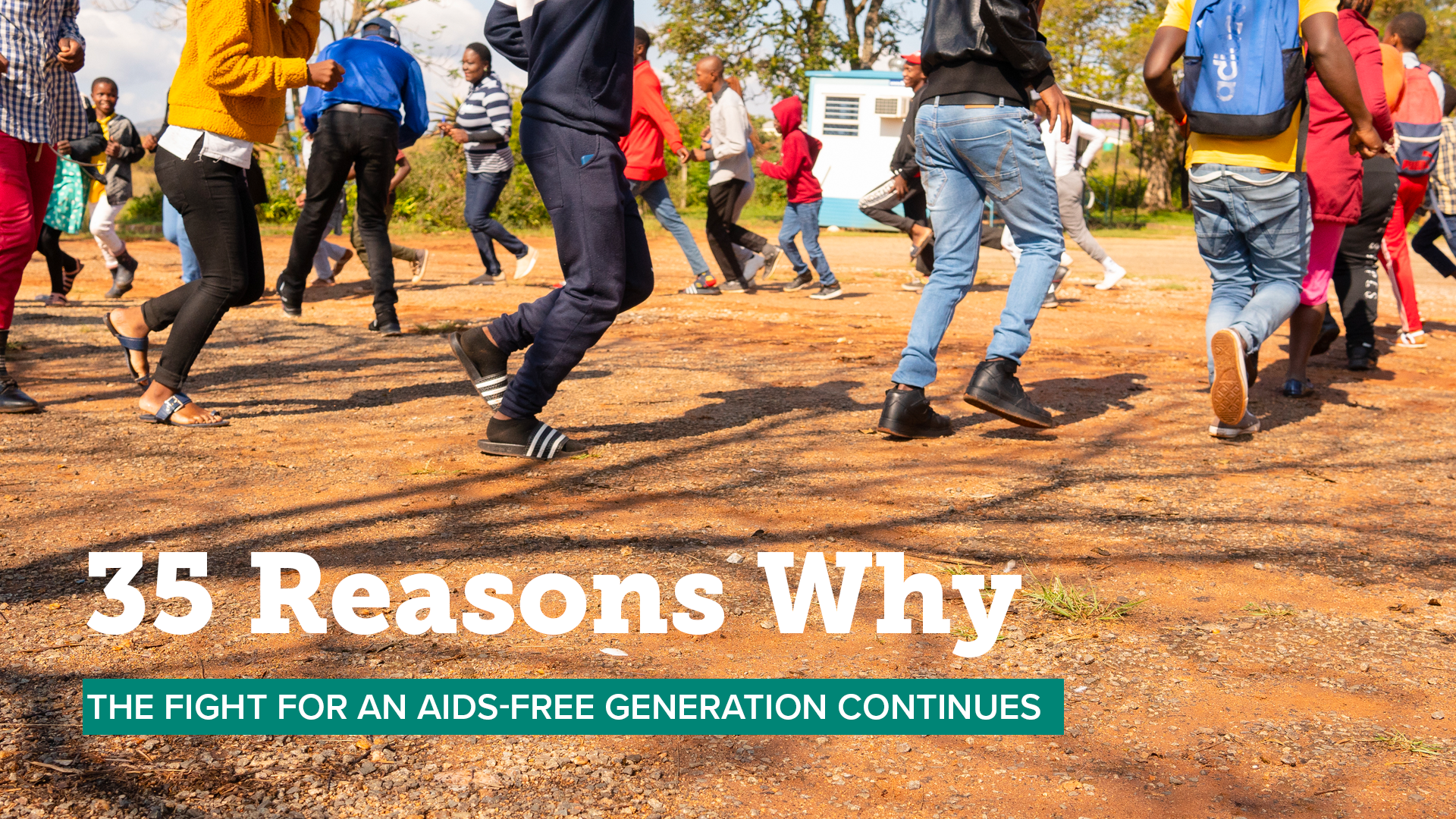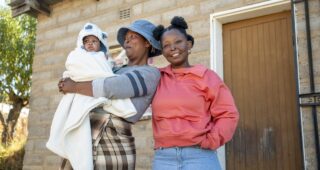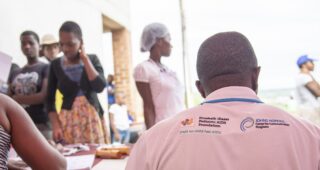35 Reasons Why
You are here
In 1988, Elizabeth Glaser sat down at her kitchen table with two close friends to solve what felt like an insurmountable problem – creating a world where no mother, child or family is devastated by HIV and AIDS.
35 years later huge progress has been made, and an AIDS-free generation is now within reach. But our fight is not over. Now is the time to finally finish the fight and make Elizabeth’s biggest dream a reality.
1. Inequities still exist for children.
Globally, 52% of children living with HIV are on ARVs, compared to 76% of adults.
View our global factsheets to learn more about the impact of HIV on children.
2. Co-infections like TB put children living with HIV more at risk.
Every year, 1.1 million children become ill with TB, worldwide. Children are especially vulnerable because they are more difficult to diagnosis and treat.
Download our Pediatric TB Strategy and learn how we addressing the critical gaps in childhood TB services.
3. Moms still face barriers to treatment.
Only 82% of women living with HIV are on ART, meaning they are at risk of passing the virus on to their children.
Read the results of a recent study about the barriers to PMTCT services for women in Homa Bay, Kenya.
4. The COVID-19 pandemic demonstrated the strengths (and weakness) of global public health infrastructure.
Finishing the fight means building resilient health systems that stand the test of future global pandemics.
Visit our Global Pandemics page to learn how we are fighting COVID-19 and investing in sustainable health systems to fight the next global pandemic.
5. AIDS can still be a death sentence.
Without treatment, 50% of children living with HIV will die before their first birthday.
Learn how EGPAF-Nigeria, our newest country program, is using quality improvement to find babies exposed to HIV and ensure they have access to the treatment they need.
6. Research still forgets about pregnant women and children.
Research has long been at the heart of EGPAF’s work but as the body of work about HIV has greatly expanded in 35 years, we see researchers continue to forget about women and children.
Read how EGPAF Ambassador Martha Cameron is advocating for including women in research.
7. Children are not consistently counted in global data collection.
What we count, shows what we care about. Many global health reporting mechanisms lump children with adults, missing on the inequalities faced by children.
View our Inequities Report and learn more about the gap between children and adults.
8. Advanced HIV Disease continues to affect thousands of people.
Those living with advanced HIV disease represent one-third of all HIV-positive patients in active care. These individuals are more prone to opportunistic infections – including TB, severe bacterial infections, and cryptococcal meningitis – that can result in an increased risk of morbidity and mortality.
Read our AHD Brief and learn more about our approach to created tailored solutions for people living with AHD.
9. Misinformation about HIV continues to thwart progress toward an AIDS-free generation.
Combating misinformation means providing evidence-based information so people can make the best decisions on how to prevent, treat, and manage HIV.
Download the Let’s Talk About Prevention brief, written by our Committee of African Youth Advisors, to provide reliable information to young people around HIV prevention.
10. Child-friendly formulations are improving, but far from perfect.
Access to antiretrovirals is essential for children and adults living with HIV. For young children, child-friendly formulations like pDTG which has a sweet taste and dissolves, improves adherence and helps them thrive.
Review the pALD Roll Out Introduction and Considerations for National Programs, available in English, French, Swahili, and Spanish.
11. Children born with HIV are now teenagers and young adults with their own unique needs.
EGPAF, we look at each stage of life as unique when creating programs for them. As children living with HIV grow into young adults living with HIV, they face new challenges around disclosure and adherence.
Read our story from Uganda, how young people are becoming peer leaders to support each other.
12. Men continue to lag behind in testing and treatment.
We want every member of a family to live HIV free. This why we create male engagement models to help men get the testing, prevention, and treatment they need.
Learn about our research to understand the changing attitudes of men in Cameroon.
13. 38.4 million people currently living with HIV.
HIV is not a problem of yesterday. Today the largest population ever is living with this once deadly disease.
Discover our solutions for strengthening healthcare capacity to better serve people living with HIV.
14. Adolescent girls and young women are facing a triple threat.
Every week, around 4,900 adolescent girls and young women aged 15 – 24 years acquire HIV. Almost three out of five young people who acquired HIV in 2021 were adolescent girls and young women.
Read our Girl-POWER Brief, and learn how EGPAF fighting the triple threat facing adolescent girls and young women.
15. HIV is not the whole story.
For people living with HIV, HIV is just a piece of their story.
Meet the EGPAF Ambassadors and learn how they are making an impact across the globe.
16. The fight to prevent mother-to-child transmission goes beyond preventing HIV.
Triple Elimination of Mother-to-Child Transmission of HIV, Syphilis and Hepatitis B is possible and a priority across our areas of work.
Download our Triple Elimination Issue Brief and learn how triple elimination goals can be achieved through sustained funding and political will.
17. Climate change poses a new and growing challenge to our fight.
As the effects of climate change intensify, we are seeing disruptions to service delivery models and challenges for people living with HIV to access the essential medical care they need.
Learn more about climate change, how it impacts the fight for an AIDS-free generation, and our approach.
18. Fighting HIV means investing in stronger communities.
The localization movement requires investment in community models to ensure sustainable HIV prevention, care, and treatment programs.
Explore how EGPAF-Uganda fostered a transition to local partners through the RHITES-SW project.
19. Stigma has not stopped.
Despite HIV becoming a manageable, chronic disease, people continue to stop seeking testing and treatment due to stigma. As long as stigma exists, HIV-free generation will be out of reach.
Read a story about young man from Mozambique, who is encouraging self acceptance and fighting stigma.
20. Women living with HIV are at increased risk of cervical cancer.
Women living with HIV are at a 5 times increased risk of getting infected with HPV, which can lead to pre-cancerous lesions and cancer. Fighting cervical cancer means supporting the health of people living with HIV.
Meet Dr. Akintade from Lesotho, who is leading the fight against cervical cancer.
21. Prevention is possible through innovations like PrEP, but barriers to access remain.
PrEP (pre-exposure prophylaxis) is considered a game changer in HIV prevention but lack of information, stocking, and difficulty with adherence create barriers to full scale implementation.
Download our issue brief on Ensuring Access and Uptake of HIV Prevention Among Key Populations in Kenya: The K-PAP Project.
22. We need long-acting ARVs.
Achieving equitable access to long-acting ARVs, has the potential to transform the global fight against HIV. But right now too many people living with HIV do not have access to this innovation.
Read the recently published article, Long-acting antiretrovirals and HIV treatment adherence.
23. Test results still take too long for many.
Rapid testing has been possible for years but for many people waiting for their HIV test results can take weeks. We need to expand access to rapid testing and point of care early infant diagnosis (POC EID).
Review our lessons learned from integrating POC EID in national health systems with support from Unitaid.
24. Third-line treatment is still inaccessible to many children.
Treatment failure occurs when a person living with HIV is adhering to treatment but not achieving viral suppression. In these cases, second-line or third-line treatment options can help, but only if they are available.
Watch Sheldon’s Story and learn about the impact of third-line treatment for children.
25. Digital health solutions can improve patient experience and adherence.
Electronic medical records (EMR) have helped revolutionize how patient history and treatment plans are storied and shared. Expansion of these systems is necessary to ensure a sustainable response to HIV.
Learn how Cloud EMR has impacted patients and providers in Homa Bay County, Kenya.
26. Early childhood development invests in whole family health.
Healthy, happy families require investing in holistic programs, like early childhood development, to help children and their caregivers thrive.
Read how ECD programs in Tanzania are engaging fathers for winning results.
27. Children continue to be left out of health policy.
Children are not just little adults; they have unique needs and need health policies designed specifically for them.
Visit and learn more about how EGPAF is advocating for children at the national, regional, and global levels.
28. Local communities are taking the lead.
From peer mentors to mother support groups to hyper-local community advocacy groups, communities are leading the fight for an AIDS-free generation.
Watch members of an HIV-free generation live a happy, healthy life thanks in part to the community support network built by their mothers.
29. More healthcare workers are needed to sustain the fight.
A key part of sustaining the fight for an AIDS-free generation is building up the healthcare workforce.
Learn how community health volunteers (CHVs) in Kenya helped supplement the healthcare workforce to fight COVID-19 and ensure consistency of services.
30. Conflict makes fighting HIV more difficult.
Political instability and conflict make adhering to treatment and accessing healthcare services more difficult.
31. We have made major progress.
Since 2000, there has been a 75% decline in deaths in kids and a 70% decline in infections in children.
Listen to Laura Guay’s Groundswell interview with Jake Glaser, as they discuss the changes in the fight for an AIDS-free generation.
32. Pediatric specific funding is decreasing.
Approximately 6% to 7% of the fiscal year (FY) 2020 U.S. President’s Emergency Plan for AIDS Relief (PEPFAR) funding was for dedicated pediatric services, and pediatric-focused funding from private donors is decreasing.
Download our advocacy brief to learn how to maximize funding opportunities.
33. Every day 430 children acquire HIV.
Because their families lack access to the health services, they need to prevent transmission. Prevention is possible.
View our prevention of mother-to-child transmission (PMTCT) fact sheet to learn more about our work.
34. Every family deserves to be happy and healthy.
Our vision is a world where children and families live free of HIV/AIDS.
Read how one family from Mozambique is thriving.
35. Elizabeth’s dream is within reach.
35 years into this fight, we now have the tools to achieve an AIDS-free generation. Now is the time for everyone to stand up and finish the fight.
Watch our Founder’s Day Video and see Elizabeth’s dream in action.
We are calling on partners, peers, and people around the globe to stand up to say
Now is the Time!
Join our fight to achieve an AIDS-free generation
Team EGPAF
Global
General




